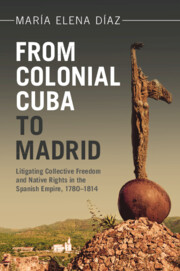 From Colonial Cuba to Madrid
From Colonial Cuba to Madrid Book contents
- From Colonial Cuba to Madrid
- Afro-Latin America
- From Colonial Cuba to Madrid
- Copyright page
- Contents
- Figures and Tables
- Acknowledgments
- Introduction
- 1 Imperial Reform, Privatization, and Enslavement
- 2 An Unorthodox Pueblo and Its Apoderados
- 3 Making the Case for Collective Freedom
- 4 Native Bonds, Native Rights
- 5 The Council’s Ruling and the Politics of Litigation
- 6 A “Pernicious” Communication
- 7 Violence, Marronage, and Litigation
- 8 The Final Outcome of the Case
- 9 The Nineteenth-Century Afterlife of the Freedom Edict of 1800
- Conclusion
- References
- Index
5 - The Council’s Ruling and the Politics of Litigation
Published online by Cambridge University Press: 14 November 2024
- From Colonial Cuba to Madrid
- Afro-Latin America
- From Colonial Cuba to Madrid
- Copyright page
- Contents
- Figures and Tables
- Acknowledgments
- Introduction
- 1 Imperial Reform, Privatization, and Enslavement
- 2 An Unorthodox Pueblo and Its Apoderados
- 3 Making the Case for Collective Freedom
- 4 Native Bonds, Native Rights
- 5 The Council’s Ruling and the Politics of Litigation
- 6 A “Pernicious” Communication
- 7 Violence, Marronage, and Litigation
- 8 The Final Outcome of the Case
- 9 The Nineteenth-Century Afterlife of the Freedom Edict of 1800
- Conclusion
- References
- Index
Summary
Chapter 5 turns to the law in action and the politics of litigation involving adjudication and interpretations of the law. The chapter opens with an examination of the Council of the Indies’ initial judgment in September 1784 on the plaintiffs’ case. Based on a narrow reading of slave law and on pro-slavery policies, the ruling rejected the plaintiffs’ controversial claim to collective freedom and to the criteria of freedom presented by the plaintiffs’ brief but allowed hearings to determine ambiguous cases and stipulated the criteria to be utilized by colonial courts in those cases. The ruling gave way to a cascade of hearings and legal actions in lower-level colonial courts and to a conflict of interpretation over the imperial ruling. Ordinary enslaved and fugitive cobreros dispersed throughout the island became direct participants in the judicial arena at this point as they directly engaged in the politics of litigation for freedom in colonial courts. The chapter shows the way imperial and colonial authorities centralized and controlled judicial outcomes but also the room for maneuvering available in some cases.
Keywords
- Type
- Chapter
- Information
- From Colonial Cuba to MadridLitigating Collective Freedom and Native Rights in the Spanish Empire, 1780–1814, pp. 178 - 207Publisher: Cambridge University PressPrint publication year: 2024
